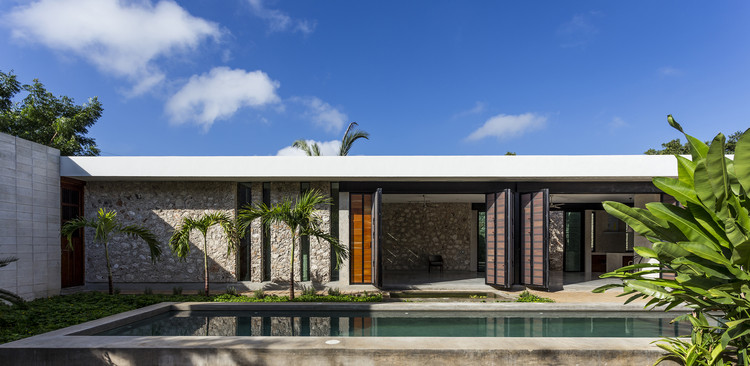
-
Architects: Taller Estilo Arquitectura
- Year: 2015
-
Photographs:David Cervera

Text description provided by the architects. The project is located in the village of Cholul, a small town in the municipality of Merida in Yucatan, Mexico. In an area of 1500 m2.

The architectural program: lobby, multifunctional space (living room, kitchen) terrace, studio, workshop, master bedroom, guest bedroom, service area, pool and garden. The idea: to build a home that meets the conditions of the context, to make the most of the natural resources available and maximize quality and comfort.
.jpg?1450834052)
A welcome esplanade consisting of pre-existing vegetation is connected to the house and the almost symmetrical masonry walls, the interior circulation begins in the garden lobby, focused on a biome with a small ecosystem to prevent the spread of mosquitoes. A multipurpose lightened concrete lattice gives us a glimpse of the space composed of living room and kitchen, embraced by courtyards, one dry and the other wet. The master bedroom is superimposed on the ground on a platform, as a unique hierarchical element which allows a general view of all areas of the project.

The guest bedroom wrapped in stone walls from the region is absent from the program to recreate a space of tranquility facing the surrounding vegetation. Finally, the workshop closes the central courtyard with the simplicity of the exposed block and the modular partitions borrowed from the typical houses of the village.

We base our proposal on the use of indigenous materials such as local stone, natural light, water, vegetation and the memory of the town, materializing it through the use of only exposed block walls, polished concrete floors, masonry walls and the central courtyard as organizing axis. The natural environment and climate of the place was also a great inspiration for the design, as it is linked to the earth and the people that inhabit it, providing a symbolic structure.

With our project, we intend to leave a testimony of popular culture, preserving traditional materials and construction systems, as they are a vital heritage that must be protected and preserved. Achieving the protection of intangible manifestations as the set of symbols, values, skills, meanings and cultural heritage of the Mayan people.




















.jpg?1450834052)
.jpg?1450834039)
.jpg?1450834161)
.jpg?1450834090)
.jpg?1450834133)
.jpg?1450834172)
.jpg?1450834077)
.jpg?1450834186)
.jpg?1450834065)
.jpg?1450834145)
.jpg?1450834105)
.jpg?1450834120)
